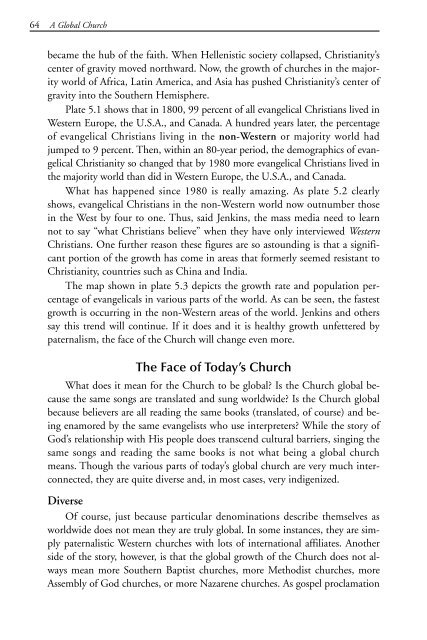discovering missions - Southern Nazarene University
discovering missions - Southern Nazarene University
discovering missions - Southern Nazarene University
Create successful ePaper yourself
Turn your PDF publications into a flip-book with our unique Google optimized e-Paper software.
245187 Disc Missions ins 9/6/07 1:04 PM Page 64<br />
64 A Global Church<br />
became the hub of the faith. When Hellenistic society collapsed, Christianity’s<br />
center of gravity moved northward. Now, the growth of churches in the majority<br />
world of Africa, Latin America, and Asia has pushed Christianity’s center of<br />
gravity into the <strong>Southern</strong> Hemisphere.<br />
Plate 5.1 shows that in 1800, 99 percent of all evangelical Christians lived in<br />
Western Europe, the U.S.A., and Canada. A hundred years later, the percentage<br />
of evangelical Christians living in the non-Western or majority world had<br />
jumped to 9 percent. Then, within an 80-year period, the demographics of evangelical<br />
Christianity so changed that by 1980 more evangelical Christians lived in<br />
the majority world than did in Western Europe, the U.S.A., and Canada.<br />
What has happened since 1980 is really amazing. As plate 5.2 clearly<br />
shows, evangelical Christians in the non-Western world now outnumber those<br />
in the West by four to one. Thus, said Jenkins, the mass media need to learn<br />
not to say “what Christians believe” when they have only interviewed Western<br />
Christians. One further reason these figures are so astounding is that a significant<br />
portion of the growth has come in areas that formerly seemed resistant to<br />
Christianity, countries such as China and India.<br />
The map shown in plate 5.3 depicts the growth rate and population percentage<br />
of evangelicals in various parts of the world. As can be seen, the fastest<br />
growth is occurring in the non-Western areas of the world. Jenkins and others<br />
say this trend will continue. If it does and it is healthy growth unfettered by<br />
paternalism, the face of the Church will change even more.<br />
The Face of Today’s Church<br />
What does it mean for the Church to be global? Is the Church global because<br />
the same songs are translated and sung worldwide? Is the Church global<br />
because believers are all reading the same books (translated, of course) and being<br />
enamored by the same evangelists who use interpreters? While the story of<br />
God’s relationship with His people does transcend cultural barriers, singing the<br />
same songs and reading the same books is not what being a global church<br />
means. Though the various parts of today’s global church are very much interconnected,<br />
they are quite diverse and, in most cases, very indigenized.<br />
Diverse<br />
Of course, just because particular denominations describe themselves as<br />
worldwide does not mean they are truly global. In some instances, they are simply<br />
paternalistic Western churches with lots of international affiliates. Another<br />
side of the story, however, is that the global growth of the Church does not always<br />
mean more <strong>Southern</strong> Baptist churches, more Methodist churches, more<br />
Assembly of God churches, or more <strong>Nazarene</strong> churches. As gospel proclamation

















